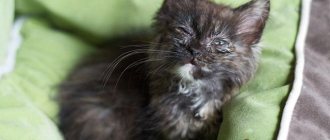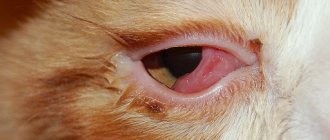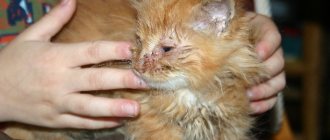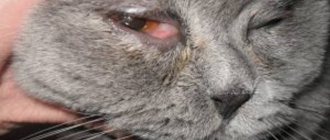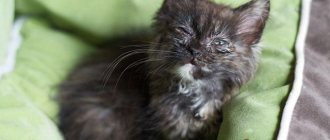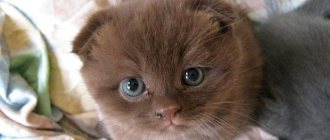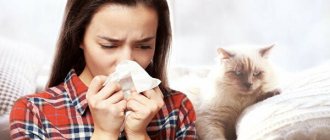Respiratory diseases in cats are widespread. The incidence of viral or parasitic etiologies is higher in young cats and outdoor animals. Cats that have free access to the outdoors are at risk of injury or bites. This may be the cause, for example, of pyothorax. The incidence increases in older cats.
The main groups of respiratory diseases in cats include the following:
- Infectious: rhinitis, tracheobronchitis and pneumonia of viral, bacterial, protozoal (for example, toxoplasmosis), or fungal etiology;
- Parasitic: as a result of direct effects of parasites on the organs of the respiratory system or secondary immune responses to migrating larvae or dead parasites;
- Inflammatory: chronic bronchial diseases, allergic bronchitis, inflammatory diseases of the respiratory tract, chronic obstructive pulmonary disease and interstitial lung disease;
- Congenital or acquired: brachycephalic syndrome (in Persian cats), tracheal stenosis, ciliary dysfunction, pleural diseases, diaphragmatic hernia;
- Tumor: primary tumors of the nose, larynx, trachea and lungs; metastatic disease;
- Cardiovascular: Cardiomyopathy/heart failure with pulmonary edema, pulmonary hypertension, pulmonary embolism;
- Injuries associated with obstruction of the airway or damage to the lung parenchyma as a result of inhalation of irritants (cigarette smoke, fire smoke) or aspiration of foreign objects (grass, food, gastric juice).
Why does a cat sneeze, have watery eyes or a stuffy nose: causes and symptoms
Sneezing occurs for a number of reasons.
Why does a cat sneeze and his eyes water?
The most common of them is inhalation of dust, which leads to irritation of the mucous membrane. But sometimes this sign, combined with lacrimation, is one of the signs of a pathological process.
Possible reasons:
- Allergy. If your pet has an allergic reaction, it can be recognized by frequent sneezing. This is especially true after direct contact with the allergen. Additional signs: skin rash, shortness of breath, vomiting.
- Cold. When the body is hypothermic, in addition to the main symptoms, there is nasal discharge, fever, and cough.
- Infectious pathologies. The cause of development is fungi, bacteria, infections. Symptoms of diseases can vary dramatically, but there are also common signs: weakness, apathy, lack of interest in food and games, upset bowel movements, mucous discharge from the eyes.
- Foreign body stuck in the nose. Cats can get fine gravel, insects, blades of grass, and more in their noses. In this case, the sneezing is constant, hiccups are constantly rubbing the nose with the paw. Additional symptoms: restless behavior, difficulty breathing, and in some cases, bleeding from the nose.
- Polyps. Formations in the nose can also provoke sneezing, which is combined with heavy discharge, as well as snoring.
- Asthma. Additional signs include difficulty breathing, hoarseness, weakness, apathy, and attempts to swallow air.
- Oncology. This reason is extremely rare. In addition to general symptoms, the presence of malignant tumors can be recognized by bleeding, excessive lacrimation, sudden weight loss, and loss of smell.
- Internal parasites. When worms infect the respiratory system, symptoms similar to a cold also appear. The presence of parasites can be recognized by the depressed state of the cat, hair loss in clumps, sudden weight loss, and intestinal dysfunction.
What to do
The cat’s body, or rather its protective function, is arranged as follows: to any irritant there is an immediate response, which gives a signal that some kind of deviation has occurred in the cat’s body. Sneezing and the flow of tears in a cat may indicate that some foreign object has entered the eye, or may also signal the occurrence of a serious illness. One way or another, if you notice these signs in your pet, you should carefully observe it for some time. And if the presence of mechanical damage to the eyes and nasopharynx is not confirmed, and in addition the cat becomes lethargic, its appetite worsens, its nose becomes hot, a cough appears, and the temperature rises, you should immediately take the cat to the veterinarian to find out the reasons.
Main problems
There are many conditions characterized by sneezing and watery eyes, but some are diagnosed more often than others. It is worth considering them separately. If other significant symptoms are present, pathology can be identified and treated.
Be sure to read:
A cat eats poorly: normal or pathological, reasons, first aid, what to do, how to get it to eat
How to tell if your cat has a cold
The cause of the disease is hypothermia of the pet. This is facilitated by a sharp temperature change. To do this, your pet just needs to play actively and then go outside during the cold season.
Swimming in cold water, jumping in the snow, and staying in the rain also contribute to the development of colds.
Characteristic features:
- cough;
- lethargy;
- conjunctivitis;
- temperature increase, but insignificant;
- lack of interest in food;
- snot.
Important! Cold symptoms are in many ways similar to other more serious pathologies, and if in doubt, you should visit a veterinarian and clarify the diagnosis.
To recover, you need to provide your pet with peace, warmth and rest. It is recommended to periodically wash your eyes and nose with a cotton swab dipped in clean water at a comfortable temperature.
If the provoking factor is reduced immunity, then it is recommended to use vitamins and immunomodulators as agreed by the veterinarian. A cold goes away within 5-7 days.
Symptoms of laryngitis
The disease is characterized by inflammation of the mucous membrane of the mouth and larynx.
The cause of development is hypothermia of the throat
The cause of development is hypothermia of the throat as a result of eating cold food from the refrigerator or water, as well as after a long stay outside in winter or exposure to acrid smoke.
Symptoms:
- dry, hysterical cough, gradually turning into a wet one;
- swelling of the oral mucosa;
- foamy discharge from the mouth after a prolonged cough;
- restless sleep;
- wheezing.
To treat laryngitis, various medications are used depending on the cause of development. Only a veterinarian will prescribe an adequate course of therapy.
Attention! Laryngitis can be a sign of deadly viruses such as rabies, so you should see a doctor if these symptoms appear.
Rhinitis in cats
Rhinitis in cats
The pathological process develops against the background of hypothermia, allergies, parasites and various infections. At the same time, the cat has difficulty breathing and constantly opens his mouth.
Additional symptoms:
- inflamed lymph nodes under the jaw;
- sniffling;
- snore;
- dyspnea;
- snort;
- decreased activity;
- lack of appetite.
It is impossible to try to treat rhinitis without knowing the cause of its occurrence. This threatens to significantly complicate the situation and deteriorate the pet’s well-being. To prescribe therapy, consultation with a veterinarian is necessary.
Sinusitis in cats
Development is caused by a viral or bacterial infection. Sinusitis appears against the background of sinusitis. Mucus accumulates in the maxillary sinuses, and when infection occurs, suppuration occurs.
First signs:
- rubbing the nose with a paw;
- purulent mucus from the nose with an unpleasant odor;
- food preferences change (the cat prefers liquid and warm food);
- mouth breathing;
- the temperature rises by 1-3 degrees.
Be sure to read:
One of the cat's eyes is watering: reasons, what to do at home, medications and folk methods
If sinusitis is suspected, the animal must be taken to a veterinarian and a series of tests must be carried out to confirm the disease.
Treatment is carried out with antibiotics, and in advanced cases, trepanation is used with washing the sinuses with disinfectant solutions.
Allergy
Sneezing and watery eyes may be an allergic reaction . Allergy triggers are often pollen, industrial feed, animal care products, dust, etc.
Sneezing and watery eyes may be an allergic reaction
It is important that the owner can track why the cat developed unpleasant symptoms. This will prevent contact with the allergen.
In the advanced form, additional symptoms appear in the form of:
- vomiting;
- swelling of the mucous membrane;
- skin itching;
- scratching the nose with a paw.
For treatment, antihistamines are used, which are administered orally or intramuscularly.
Polyp formation
Polyps in a cat can be either congenital or acquired due to an untreated allergy or infection. Symptoms may not appear immediately, but as the tumor grows, the pet begins to experience discomfort.
Additional signs:
- snore;
- mouth breathing;
- weight loss;
- head shaking;
- discharge from the ear;
- lack of coordination;
- depressed state.
Polyps are removed surgically. Then a course of antibiotics and corticosteroids is prescribed to prevent the inflammatory process.
Asthma
The suspected cause of asthma is allergies. The disease can be recognized by a paroxysmal dry cough and shortness of breath.
The appearance of unpleasant symptoms can also be caused by other pathologies. But only an experienced specialist can make an accurate diagnosis.
The priority treatment drugs are hormonal agents in the form of tablets, injections, and sprays. Additionally, bronchodilators are prescribed, used during attacks to expand the patency of the bronchi.
Other possible causes of runny nose and sneezing
The appearance of unpleasant symptoms can also be caused by other pathologies. But only an experienced specialist can make an accurate diagnosis.
Other provoking factors:
- foreign object;
- chlamydia;
- viral leukemia;
- immunodeficiency virus
- dental diseases.
When should a sick person see a doctor?
A healthy body can and should overcome a mild ARVI that occurs without serious symptoms in 5–7 days. If within a week the symptoms do not go away or even worsen, we can almost certainly talk about a complication of a seemingly unimportant disease.
The patient may experience symptoms of laryngitis or pharyngitis, tonsillitis, rhinitis, signs of inflammation of the paranasal sinuses - sinusitis or sinusitis, otitis, tracheitis, bronchitis and even pneumonia. In this case, even if the temperature has not risen, you should definitely contact either your family doctor or a good ENT doctor in Moscow.
Doctors include dangerous symptoms:
- difficulty or increased breathing;
- the appearance of wheezing;
- long lasting cough;
- chest pain;
- significant increase in temperature;
- severe pain in the forehead;
- fainting state;
- confused consciousness, inability to navigate in space;
- severe vomiting.
Correct diagnosis and treatment of possible diseases
The effectiveness of therapy directly depends on the correctness of the diagnosis. To identify pathology, it is important that the owner is able to determine why the pet developed unpleasant symptoms.
The more information the pet owner provides, the faster a diagnosis will be made.
What to look for when making a diagnosis
Even before visiting a doctor, you can assume a diagnosis based on your observations. This will significantly narrow the list of suspected diseases.
If sneezing is rare, but at the same time there is profuse lacrimation, and mucus is flowing, the eyes are swollen and breathing is difficult, then an allergy is presumably to blame.
When general symptoms are combined with fever, swollen tonsils and green mucus, we can conclude that there is an infection. If sneezing is accompanied by bad breath, your pet may have dental problems.
Be sure to read:
A cat sneezes and snot: how to treat it at home, the causes of the disease, when it is considered normal
What to do if a kitten sneezes and its eyes fester?
In case of purulent exudate, it is recommended to wash the pet’s eyes with a weak solution of boric acid or furatsilin 3 times a day.
As part of complex therapy, the antibiotics Maxidin and Fosprenil are used to reduce the inflammatory process, as well as the drugs Gamavit and Baksin, which strengthen the immune system.
What to do if your kitten starts sneezing frequently and has watery eyes
Watery eyes appear with colds and allergies. In the first case, it is enough to wash your eyes three times a day with furatsilin, instill drops for a runny nose and provide complete rest to your pet. And in the second case, contact with the allergen should be prevented and antihistamines should be used.
In what cases is a visit to the veterinarian necessary?
If the discomfort is caused by a virus, then it is difficult to cope with the pathology on your own. Any delay can be dangerous for the pet's life.
Signs when you should not put off a visit to the veterinarian:
- severe swelling of the oral mucosa, impairing breathing;
- bleeding;
- fever against a background of general apathy and loss of strength;
- copious discharge of pus from the eyes and ears;
- wheezing and whistling when inhaling and exhaling;
- digestive disorders, making it impossible to eat.
You should also visit a veterinarian if the cat was picked up from the street and needs vaccinations.
Preventive procedures
If there is no obvious problem at the moment, you can use the recommendations for prevention. A warm decoction of medicinal plants, which are also intended for humans, drops that do not contain an antibiotic, or green tea are suitable for this.
If your cat's eyes are watery due to an infectious disease confirmed by a veterinarian, then tetracycline ointment can be used.
To treat bacterial infections, “Diamond Eyes” drops or some of their analogues are used.
Physiological causes of sneezing
If the condition of the mustachioed pet is stable, and the duration of sneezing does not cause concern, there is a high probability of a physiological cause. In this case, the reflex is awakened by external stimuli that appear during rare cleaning or a certain microclimate in the room. Also, a sneeze can be explained by a specific body structure characteristic of a particular breed.
Ingress of dust or debris
A kitten's nose is very sensitive, and its owners are incredibly inquisitive. The mustachioed fidgets are constantly exploring something, climbing into secluded corners inaccessible to their two-legged owners. Direct contact with dust or debris irritates the nasal mucosa, causing a defensive reaction.
Try to do wet cleaning more often, but don’t go to extremes. A cat is a “liquid”. If she needs it, she will crawl through any crack, despite her parameters. It is unrealistic to achieve complete sterility, so it is enough just not to forget about regular room hygiene.
Dry indoors
Dry air dries out the secretions that lubricate the nasal mucous membranes. The protective barrier becomes thinner, increasing the likelihood of catching a cold or infection.
Lack of moisture can be noticed by peeling of your own skin and strong electrification of hair. If there are plants in the house, they begin to dry out at the tips of the leaves. Children and pets often experience coughs and runny noses. Solving the problem is quite simple - place buckets of water around the house, hang wet towels, or resort to a modern method - buy an air humidifier.
Breed Features
One of the reasons why a kitten constantly sneezes is the anatomical feature of the structure of its muzzle. This is typical for representatives of extreme breeds: exotics, Himalayans, Persians, British and Scottish. All of them were bred artificially and, unlike aboriginal cats, escaped natural selection.
The experiments of breeders trying to create an unusual appearance have led to the appearance of a funny flattened muzzle with a small nose. Despite their attractive appearance, such animals often suffer from problems with the respiratory system and are predisposed to many genetic diseases.
